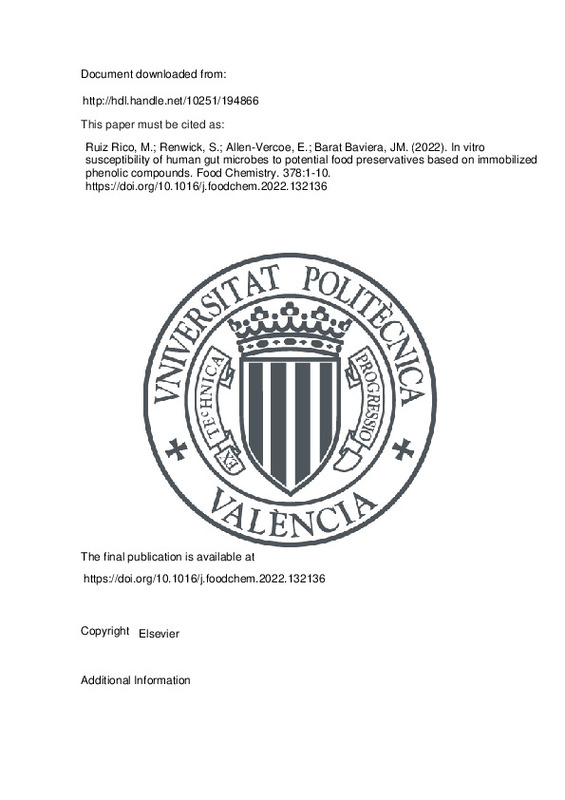JavaScript is disabled for your browser. Some features of this site may not work without it.
Buscar en RiuNet
Listar
Mi cuenta
Estadísticas
Ayuda RiuNet
Admin. UPV
In vitro susceptibility of human gut microbes to potential food preservatives based on immobilized phenolic compounds
Mostrar el registro sencillo del ítem
Ficheros en el ítem
| dc.contributor.author | Ruiz Rico, María
|
es_ES |
| dc.contributor.author | Renwick, Simone
|
es_ES |
| dc.contributor.author | Allen-Vercoe, Emma
|
es_ES |
| dc.contributor.author | Barat Baviera, José Manuel
|
es_ES |
| dc.date.accessioned | 2023-07-12T18:00:49Z | |
| dc.date.available | 2023-07-12T18:00:49Z | |
| dc.date.issued | 2022-06-01 | es_ES |
| dc.identifier.issn | 0308-8146 | es_ES |
| dc.identifier.uri | http://hdl.handle.net/10251/194866 | |
| dc.description.abstract | [EN] The development of novel food preservatives based on natural antimicrobials such as phenolic compounds is increasing, but their safety should be established before use, including evaluating their impact on the gut microbiota. This work explored the influence of antimicrobial phenolics presented in different forms on selected human gut microbiota members through in vitro susceptibility tests. The bacteria tested exhibited a wide range of susceptibilities to phenolics depending on the molecule structure and mode of administration. Agathobacter rectalis and Clostridium spiroforme, members of the phylum Firmicutes, were the most sensitive strains. Susceptibility was strain- and species-specific, suggesting that it may not be possible to easily extrapolate results across the human microbiome in general. Species of other phyla including Bacteroidetes, Actinobacteria, Proteobacteria and Verrucomicrobia were more resistant than Firmicutes, with growth of some strains even enhanced. Our results provide insights into the biocompatibility of free and immobilized phenolics as potential food additives. | es_ES |
| dc.description.sponsorship | The authors gratefully acknowledge the financial support from the grant RTI2018-101599-B-C21 of the project "Retos Investigacion" funded by MCIN/AEI/10.13039/501100011033 and by "ERDF A way of making Europe". MRR acknowledges the Generalitat Valenciana for her postdoctoral fellowship (APOSTD/2019/118). We also thank A. V. Robinson and S. J. Vancuren for providing stock of the isolated gut microbiota strains. | es_ES |
| dc.language | Inglés | es_ES |
| dc.publisher | Elsevier | es_ES |
| dc.relation.ispartof | Food Chemistry | es_ES |
| dc.rights | Reconocimiento - No comercial - Sin obra derivada (by-nc-nd) | es_ES |
| dc.subject | Gut microbiota | es_ES |
| dc.subject | Natural antimicrobial | es_ES |
| dc.subject | Covalent immobilization | es_ES |
| dc.subject | Food additives | es_ES |
| dc.subject | Agathobacter | es_ES |
| dc.subject | Clostridium | es_ES |
| dc.subject.classification | TECNOLOGIA DE ALIMENTOS | es_ES |
| dc.title | In vitro susceptibility of human gut microbes to potential food preservatives based on immobilized phenolic compounds | es_ES |
| dc.type | Artículo | es_ES |
| dc.identifier.doi | 10.1016/j.foodchem.2022.132136 | es_ES |
| dc.relation.projectID | info:eu-repo/grantAgreement/AEI/Plan Estatal de Investigación Científica y Técnica y de Innovación 2017-2020/RTI2018-101599-B-C21/ES/DESARROLLO Y APLICACION DE SISTEMAS ANTIMICROBIANOS PARA LA INDUSTRIA ALIMENTARIA BASADOS EN SUPERFICIES FUNCIONALIZADAS Y SISTEMAS DE LIBERACION CONTROLADA/ | es_ES |
| dc.relation.projectID | info:eu-repo/grantAgreement/GENERALITAT VALENCIANA//APOSTD%2F2019%2F118//CONTRATO POSDOCTORAL GVA-RUIZ RICO. PROYECTO: DESARROLLO DE NUEVOS SISTEMAS ANTIMICROBIANOS / | es_ES |
| dc.rights.accessRights | Abierto | es_ES |
| dc.contributor.affiliation | Universitat Politècnica de València. Escuela Técnica Superior de Ingeniería Agronómica y del Medio Natural - Escola Tècnica Superior d'Enginyeria Agronòmica i del Medi Natural | es_ES |
| dc.description.bibliographicCitation | Ruiz Rico, M.; Renwick, S.; Allen-Vercoe, E.; Barat Baviera, JM. (2022). In vitro susceptibility of human gut microbes to potential food preservatives based on immobilized phenolic compounds. Food Chemistry. 378:1-10. https://doi.org/10.1016/j.foodchem.2022.132136 | es_ES |
| dc.description.accrualMethod | S | es_ES |
| dc.relation.publisherversion | https://doi.org/10.1016/j.foodchem.2022.132136 | es_ES |
| dc.description.upvformatpinicio | 1 | es_ES |
| dc.description.upvformatpfin | 10 | es_ES |
| dc.type.version | info:eu-repo/semantics/publishedVersion | es_ES |
| dc.description.volume | 378 | es_ES |
| dc.identifier.pmid | 35042114 | es_ES |
| dc.relation.pasarela | S\454081 | es_ES |
| dc.contributor.funder | GENERALITAT VALENCIANA | es_ES |
| dc.contributor.funder | AGENCIA ESTATAL DE INVESTIGACION | es_ES |
| dc.contributor.funder | European Regional Development Fund | es_ES |
| dc.subject.ods | 02.- Poner fin al hambre, conseguir la seguridad alimentaria y una mejor nutrición, y promover la agricultura sostenible | es_ES |







![[Cerrado]](/themes/UPV/images/candado.png)

